

|
|
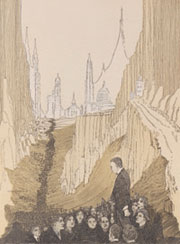 An illustration of the School of Oratory by Oscar Bergesen (WCAS18) from the Syllabus of 1918. Courtesy of The Syllabus 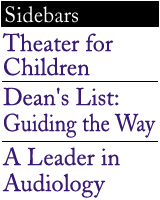
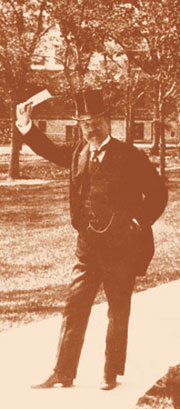 Robert McLean Cumnock 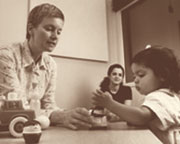 Karla McGregor, associate professor of communication sciences and disorders, works with a young patient in the Child Language Lab. Photo by Jim Ziv 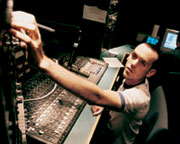 A student works the dials at WNUR in the McCoy Foundation Studios. Photo by Mary Hanlon  Michael Gottlieb and Ryan Sparacino celebrate a debate title. Photo by Jim Ziv  Travis Turner, a theater major and music theater student, moves to the music. Photo by Andrew Campbell  Performance studies students go over lines of Oscar Wilde. Photo by Mary Hanlon |
For 125 years graduates and faculty members of Northwestern University’s School of Communication have defined the word “success.” Barbara O’Keefe, dean of the school, attributes its success to taking on new challenges. “We’re always ready to examine, confront, understand and embrace new challenges,” she says, “and that has served us well. That’s what has brought us to where we are today.” The school has grown and thrived through three incarnations since its founding in 1878 by noted orator Robert McLean Cumnock — first as the School of Oratory, then as the School of Speech, and beginning in 2002, as the School of Communication. Each name change signaled the institution’s ever-increasing breadth and depth as the school’s faculty members have defined their diverse disciplines. Graduates excel in careers from acting to audiology, Broadway performance to presidential politics. “The school has a distinguished reputation for training and educating future leaders. ... The name change reflects that and provides a clear signal that we will continue our leadership in communication arts and sciences,” O’Keefe said when the change was announced. “We are the oldest communication school in the U.S., with the proudest tradition, and it is time for us to become the newest School of Communication.” So, what began with a few courses in elocution has grown into a 1,200-student, five-department institution — quite an expansion from the school’s early days when the first graduating class included just 14 students. Today a degree from the School of Communication opens doors to opportunity and elicits respect. Emmy-winning actor Peter Strauss (C69) wrote for the 1980 Theatre and Interpretation Center dedication gala program, “Whenever I am asked where I studied theater, the reply ‘Northwestern’ always prompts a nod of approval and a magical guaranteed respect. And I know that response is not exclusive [to me] — it is bestowed on all the alumni of the School of [Communication].” IN THE BEGINNING It all began with one man and his powerful voice. In 1868 Garrett Biblical Institute hired Scottish-born Robert McLean Cumnock to teach future ministers how to become more compelling speakers. Soon after Cumnock joined the Northwestern faculty with a lifetime contract. He sought to pass on his love of elocution, which he considered “a pretty thin science, but a great art.” In his classes he often read aloud passages from Shakespeare or the Bible. It wasn’t long before his spirit and talent caught the attention of the student body. In response to the growing interest, Cumnock developed a two-year certificate in elocution in 1878. And the institution now known as the School of Communication was born. Thirteen years later the trustees named the elocution curriculum the School of Oratory and assigned Cumnock to be its first dean. Thanks largely to a gift from Chicago meatpacker Gustavus Swift, Northwestern built a Venetian–Gothic-style building to serve as the school’s home. Cumnock turned down the honor of having the building named for him and instead asked that it be named for Annie May Swift, the benefactor’s daughter who became ill and passed away after attending Northwestern for one year. Built in 1895, Annie May Swift Hall remains the home of two School of Communication departments — Performance Studies and Radio/Television/Film. The School of Communication today comprises five departments: Communication Sciences and Disorders, Communication Studies, Performance Studies, Radio/Television/Film and Theatre. BROAD CURRICULUM, SPECIALIZED STUDIES Today the broadest department in the school, Communication Studies, offers courses ranging from the rhetoric of the presidency to bargaining and negotiations. Students study everything from interpersonal communication processes to popular culture — worlds away from the department’s original curriculum, oratory and elocution. Those skills, though, have not been forgotten by members of the University’s debate team. With 12 championships, there’s no debating that Northwestern is the nation’s No. 1 team. Ivy Leaguers Dartmouth and Harvard claim second place with just six titles each. And not only is Northwestern the most successful, it’s also the oldest active collegiate team in the country. Northwestern took part in the first intercollegiate debate in 1872, and by 1905 the school newspaper lamented the team’s five-year losing streak. The Daily can complain no more. Under the 1990s’ Coach of the Decade Scott Deatherage (GC94), Northwestern won its sixth title in 10 years in April. (A national committee of 40 college debate coaches also named Northwestern Program of the Decade for the 1990s and Michael Gottlieb (WCAS99) and Ryan Sparacino (C00) Team of the Decade.) HANDS-ON RESEARCH, REAL-LIFE SCIENCE The Department of Communication Sciences and Disorders is one of the nation’s most highly regarded research and clinical education programs. Faculty study audiology, voice, speech, language and learning disorders — with students by their side. Cynthia Thompson, professor of communication sciences and disorders and of neurology, is studying the benefits of therapy for patients with aphasia, language loss after a stroke. Professor Nina Kraus seeks to explain how the brain processes sound, and colleague Mario Ruggero, Hugh Knowles Professor of Hearing Sciences, examines the structure of the cochlea in mammals. Teams led by Jerilyn Logemann, Ralph and Jean Sundin Professor, develop therapies for patients with dysphasia, or swallowing disorders. In the department’s hearing, speech, language and learning clinics, students work with state-of-the-art diagnostic equipment and perform clinical work supervised by nationally certified clinicians. “It’s vitally important to their careers,” department chair Dean Garstecki says of the experience. “It’s essentially a lab experience for them in a structured, supervised environment with actual patients. “The service to the community is a bonus. As part of the training of these students, the public benefits from contemporary treatment by professionals on the cutting edge of their disciplines.” The research and treatment focus began in 1929 when Clarence Simon, professor of speech correction, created a speech clinic on campus to study and treat speech defects such as stuttering, lisping and faulty articulation. The clinic, which later became the Department of Communication Sciences and Disorders, became a leader in its field. The first two PhD students who graduated under Simon in 1936, Raymond Carhart (GC34, 36) and Paul Moore (GC30, 36), became leading researchers in hearing and speech science respectively. A 1946 report on the Program in Education of the Deaf and Hard of Hearing called Northwestern “a leading center for the education of specialists in audiology and hearing,” and the program was featured in LIFE magazine. EQUIPPED FOR LIFE Playwrights, cartoonists and storytellers, actors, performers and poets — all get their start in Northwestern’s Department of Performance Studies. Students in the department participate in a unique educational experience at Northwestern with only seven full-time faculty members, 30 undergraduate students and 25 graduate students. The personalized approach is not a new concept. In its infancy, faculty in the then-Department of Interpretation served as private instructors for students, providing one-on-one lessons on diction, interpretation and projection. As course offerings grew, new professors joined the department, bringing a change in focus, from literature and interpretation as a means of understanding literature to performance as a means for exploring a wide range of experiences and events. Those explorations and understandings shape students for life. “So what do you have if you’ve got a performance studies degree?” asks former department chair Carol Simpson Stern (G64, 68). “You’ve got imagination, curiosity, intellectual analytic skills, an understanding of culture and an understanding of performance traditions. With that, you can go and be a director, a performer, form your own company, be a political activist or a cultural anthropologist. You are really getting what Kenneth Burke [a theorist of rhetoric] calls ‘equipment for living.’ “Really, what could be better?” ON THE AIR Students in Radio/Television/Film today have access to state-of-the-art film and editing equipment, a completely student-run radio station and an award-winning faculty with years of experience. This is nothing new. The department has long been on the edge of innovation. Albert Crews (C29, GC32), an instructor, taught Radio Production and Writing for Radio in the School of Speech beginning in 1937. In 1942 the study of radio became a stand-alone department, one of the first of its kind in the country. Students gained hands-on experience by producing half-hour student-run shows for Chicago radio stations. By 1950 students learned the ropes of radio at the University’s student-run station, WNUR-FM 89.3. In one half century it grew from a live-action entertainment station to the nation’s best college radio, according to this past September’s SPIN magazine. Television entered the academic scene in 1949, when Northwestern professor Donley Feddersen (GC42) collaborated with NBC through Judith Waller, a network executive who also taught courses at the University. NBC hosted a production institute and often opened its Chicago studios to junior and senior interns. Today students edit video on high-definition editing systems, shoot special effects and learn their way around a control room in John J. Louis Hall. With a balance between theory and practice, film students learn the basics of production, screenwriting and directing. They not only receive an education that is academically sound but also have access to hands-on outlets where they can apply their learned skills and flex their creative muscles. Many participate in student-run cocurricular activities such as Niteskool, the school’s 20-year-old music, film and concert production company, and Studio 22, a film production company. “As you can see, our students have many opportunities to apply their experiences from the classroom in cocurricular activities and internships throughout the Chicagoland area,” says department chair Lawrence Lichty. “As we celebrate this anniversary, it’s wonderful to remember that this has been a tradition at Northwestern for a very long time.” POWER DEGREE It is no wonder that in 1998 Los Angeles–based Buzz magazine called a Northwestern degree “Hollywood’s power diploma.” Many of entertainment’s biggest names claim Northwestern as their alma mater. The list of past and present Hollywood alumni includes silver and small-screen actors, writers, directors and producers. The theater department also boasts alumni on Broadway. When Dominic
Missimi last went to New York, the theater professor counted 32 Northwestern
alumni on stage — in Mamma Mia, Phantom of the Opera, Hairspray
and Les Misérables, among others. In the past five years
16 graduates have earned Tony nominations. When he arrived at Northwestern, Missimi says his students complained that their musical theater education came up short. Listening to the students’ needs, Missimi founded the certificate program in conjunction with the School of Music. This rigorous and renowned program is highly selective — only 30 freshmen and sophomores majoring in theater, dance or voice are accepted into the program each year. “Ten years ago we looked forward to Northwestern being a center of music theater training,” Missimi says. “Now we are a regular force in the industry.” With strengths in theater, song and dance, Northwestern has fulfilled the 1920s’ prediction by then-dean Ralph Dennis that Northwestern would serve as a “mecca” for dramatics. And he should have known. Theater flourished under his leadership and support. Dennis added theater faculty members Garrett Leverton, Alexander Dean and Winifred Ward (C1905), the developer of children’s theater and creative dramatics (see story on page 28). Alvina Krause (C28, GC33), perhaps the best-known acting professor, taught and trained some of Hollywood’s stars during her 33 years at Northwestern, including Charlton Heston (C45), Patricia Neal (C47, H94), Paula Ragusa Benjamin (C59) and her husband, Richard Benjamin (C60). Krause, fondly called “A.K.” by her students, was the driving force behind the evolution of the acting curriculum, from a one-semester session to a full three-year program. ANOTHER 125 YEARS New technology and its influence on communication present new challenges for the school. “We’ve got to find the right mix between tradition and change for continued success,” says David Zarefsky (C68, GC69, 74), former dean and current Owen L. Coon Professor of Communication Studies. “We didn’t get to where we are by ignoring the tremendous changes taking place around us. We’ve got to look at things like globalization and diversity, but at the same time, remember our roots in rhetoric and the arts.” The school has changed, challenged and inspired communication — in the arts, in entertainment and in the communication sciences. More importantly, it has changed, challenged and inspired students for 125 years. “More than any other place I’ve seen, we treat students as partners,” O’Keefe says. “Students come in, and they create great theater on the North Shore. They’re putting on a radio station that’s listened to by millions of people in Chicago. They’re working on research projects that are funded by the National Institutes of Health. “They’re not treated like customers or even children that we’re nurturing. They’re really brought in as colleagues and given the opportunity to pursue their interests in a very professional setting. It’s all real work. … That’s why we’re so successful.” Yujin Yi (WCAS04) was a summer editorial intern with Northwestern
magazine. |